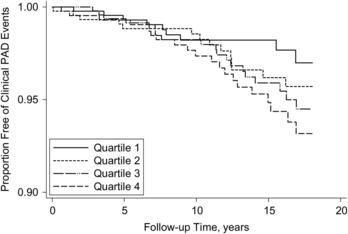Epidemiology
Association of Body Mass Index with Peripheral Arterial Disease in Older Adults: The Cardiovascular Health Study
Evidence Ranking
• B
Expert Rating
• 1
Abstract
The authors hypothesized that the absence of cross-sectional associations of body mass index (BMI; weight (kg)/height (m)2) with peripheral arterial disease (PAD) in prior studies may reflect lower weight among persons who smoke or have poor health status. They conducted an observational study among 5,419 noninstitutionalized residents of 4 US communities aged ≥65 years at baseline (1989–1990 or 1992–1993). Ankle brachial index was measured, and participants reported their history of PAD procedures. Participants were followed longitudinally for adjudicated incident PAD events. At baseline, mean BMI was 26.6 (standard deviation, 4.6), and 776 participants (14%) had prevalent PAD. During 13.2 (median) years of follow-up through June 30, 2007, 276 incident PAD events occurred. In cross-sectional analysis, each 5-unit increase in BMI was inversely associated with PAD (prevalence ratio (PR) = 0.92, 95% confidence interval (CI): 0.85, 1.00). However, among persons in good health who had never smoked, the direction of association was opposite (PR = 1.20, 95% CI: 0.94, 1.52). Similar results were observed between BMI calculated using weight at age 50 years and PAD prevalence (PR = 1.30, 95% CI: 1.11, 1.51) and between BMI at baseline and incident PAD events occurring during follow-up (hazard ratio = 1.32, 95% CI: 1.00, 1.76) among never smokers in good health. Greater BMI is associated with PAD in older persons who remain healthy and have never smoked. Normal weight maintenance may decrease PAD incidence and associated comorbidity in older age (Fig 2).
Stay updated, free articles. Join our Telegram channel

Full access? Get Clinical Tree



